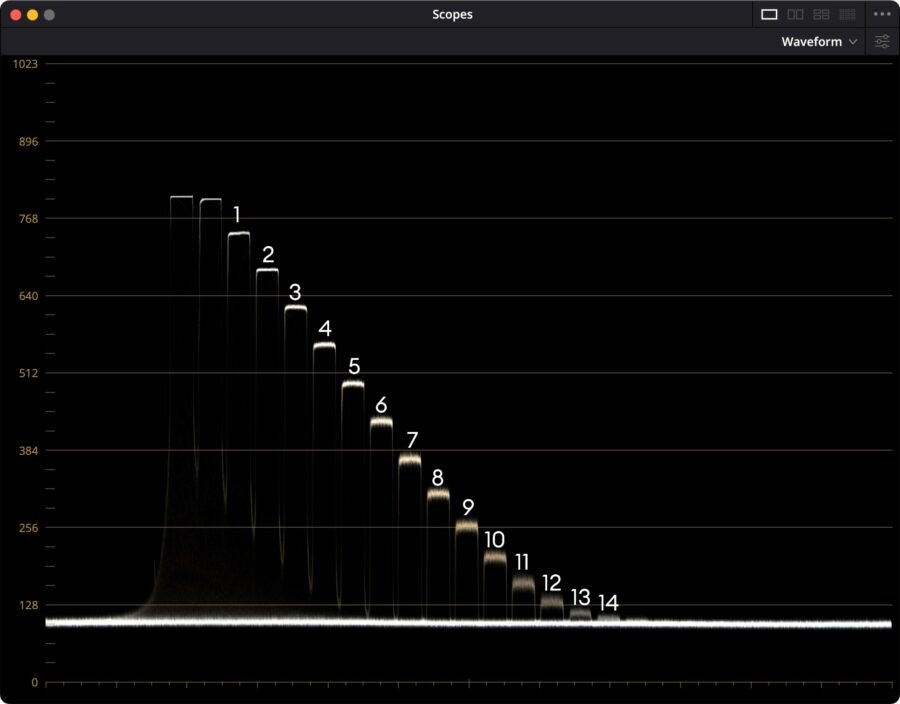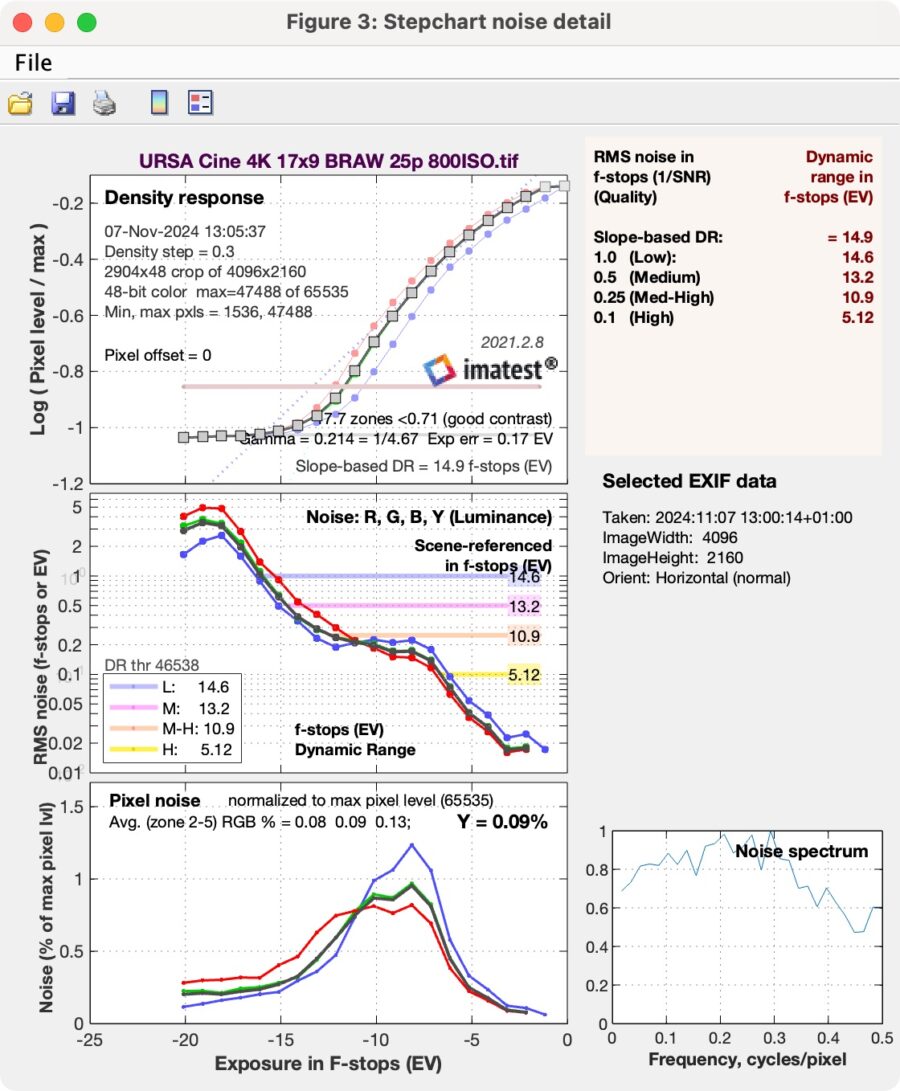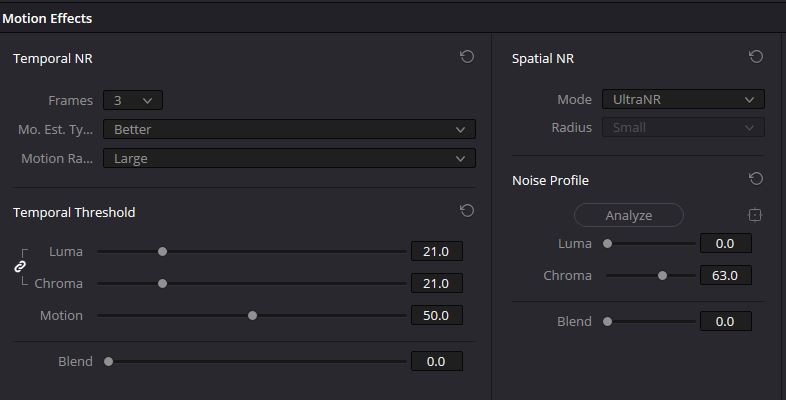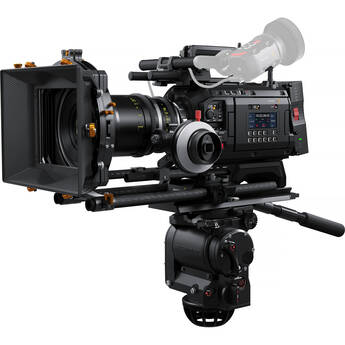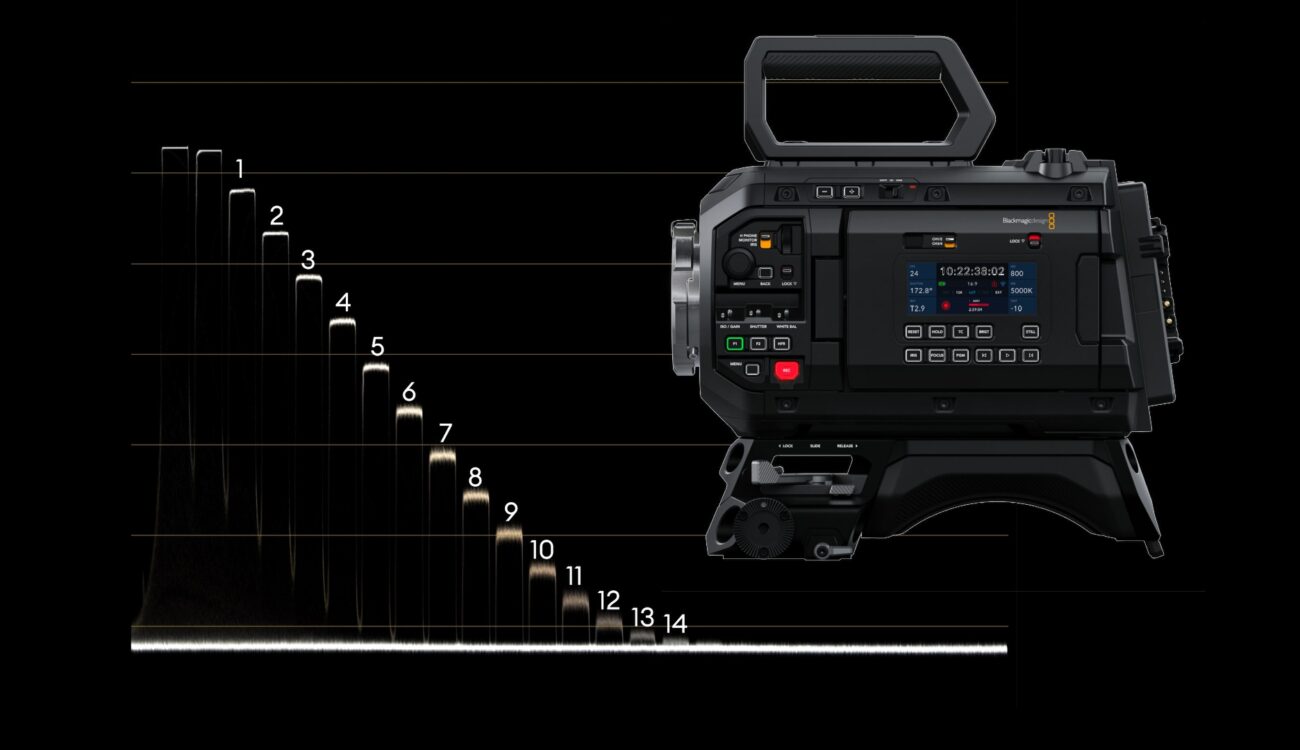
Finally the new URSA Cine 12K LF camera from Blackmagic has arrived at our CineD headquarters here in Vienna. We were really excited to run this new top-of-the-line Blackmagic camera through our lab test procedures. Curious to see the results? Then read on …
For me personally, it is always exciting to see new technology being implemented in cameras, as Blackmagic Design is doing with their RGBW full-frame sensor in the new URSA Cine 12K LF. To be honest, I have lost a bit of interest in testing new consumer cameras as they all seem to be limited by their conventional 12-bit sensor readout modes. Hence, they all fall between 11 – 12 stops of usable dynamic range and 8 – 9 stops of exposure latitude.
Therefore, testing cameras that try something different, like the Canon C70 (lab test here), which uses a dual gain output, or the new LUMIX GH7 (lab test here), which utilizes a dynamic range boost mode, or the FUJIFILM X-H2S, which has introduced a 14-bit sensor readout mode of up to 30 frames per second (lab test here) brings the fun of testing back! And that holds true, of course, as well for cameras like the ARRI ALEXA 35 with its 13-bit ARRIRAW files (lab test here).
Now, coming back to the new URSA Cine 12K LF, a quick look at the specs is absolutely stunning, to say the least. 12K resolution in 3:2 open gate mode, full-frame 8K or 4K at 180 frames per second, is pushing against the boundaries of what is available on the market so far. And then, another look at the price, and I simply can’t believe what Blackmagic is pulling off again here!
Please head over here and here for all the CineD coverage on this new camera.
Again, I want to give a big shout-out to my colleague Florian Milz, who was a big help in shooting and analyzing the tests.
Rolling Shutter of the URSA Cine 12K LF camera
Rolling shutter was tested using our 300Hz flashlight. Let’s start with 12K open gate 3:2 mode:
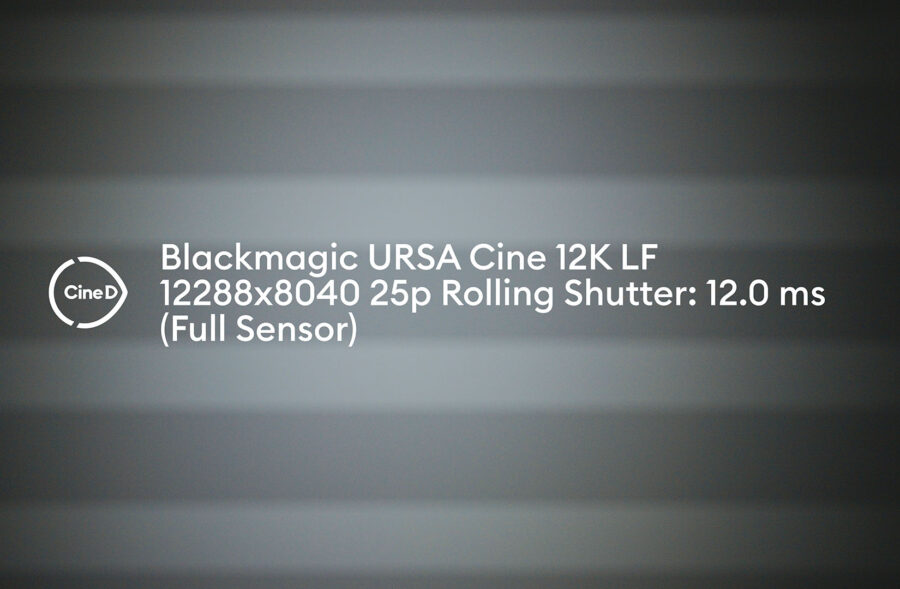
We get 12ms of rolling shutter (less is better). That is a very, very good result for an open gate full-frame sensor! The interesting part about this new sensor design (RGBW) from Blackmagic is the fact that if it is switched to lower resolutions like 8K and 4K, the readout speed improves.
We reached out to our contacts at Blackmagic Design, and they explained the following to us:
“The in-camera scaling in the 8K and 4K formats on the URSA Cine 12K LF (and the URSA Mini Pro 12K as well) use two different mechanisms; one is a scaling step on the sensor itself which increases the readout speed and reduces rolling shutter skew, the other works in the frequency domain of the Blackmagic RAW codec. They generally help in reducing the amount of data to be recorded in the lower resolution formats while retaining the full field of view, but they are also preferable in case of fast movement as rolling shutter skew becomes minimal. However, these mechanisms don’t increase the dynamic range any further. Recording in 12K and scaling in the spatial domain in Resolve would be recommended for achieving best dynamic range.”
We will look at dynamic range in the next section below, but for now, let’s have a look at the 8K full-frame:
We are getting 5.5ms of rolling shutter. Wow – this is the second-best result (for rolling shutter sensors) behind the Sony Venice 2. The same value is obtained for a 4K full-sensor width readout. In cropped 9K mode (~1.3crop), we obtain 7.4ms.
Dynamic Range of the URSA Cine 12K LF at ISO 800
If you don’t know how we test dynamic range, please head over here.
All dynamic range results were shot at the highest available bitrate in Blackmagic RAW 3:1 at ISO800. Files were developed in the camera RAW tab of DaVinci Resolve 19 (using Wide Gamut Gen 4 / 5 and Film Gen 5). So, let’s have a look at the waveform plot of 12K 3:2 open gate mode:
We can identify 13 stops, if not 14, above the noise floor, and a 15th and 16th stop buried inside the noise floor. IMATEST exhibits these results:
We get 13 stops at a signal-to-noise ratio of 2 (SNR) and 14.5 stops at SNR = 1. Wow – these are the best results we ever got from a Blackmagic camera. For comparison, our benchmark so far, the ARRI Alexa mini LF, scored 13.4 / 14.5 stops at SNR = 2 / 1 in ARRIRAW (lab test here). A quick look at the lower right-hand graph “noise spectrum” reveals that high-frequency detail is, however, not preserved so well as amplitudes drop to 0.2. But we are talking about preserving 12K resolution ;-)…
Now, do we have a camera in our hands that is finally getting close to the ARRI Alexa Mini LF?
Well, you could argue that the Alexa MINI LF only shoots 4K resolution, so let’s have a quick look at what happens if we downscale the 12K files to 4K in DaVinci Resolve 19:
And here we go – we finally have a camera that shows better results (using RAW) than the ARRI Alexa Mini LF. Also, if we look at the lower right-hand side graph (noise spectrum), we can see that amplitudes don’t decrease until very high resolutions. Hence, this is a super detailed 4K image!
Now, let’s quickly test the official statement of Blackmagic above to see what happens if we use the full sensor with in camera 4K mode (on sensor scaling). The dynamic range should be similar to the 12K mode.
Confirmed – we get similar if not slightly better, results to the 12K mode. Please head over to the CineD Database for more results at different resolutions and framerates. Spoiler alert – no matter what the framerate is in any given resolution, the dynamic range stays absolutely consistent. Fantastic!
Now, moving on to the latitude test below, we will see if the URSA Cine 12K LF can keep up with the Alexa Mini LF in our real-world studio scene! Typically, high-resolution sensors from Blackmagic were hampered by fixed pattern noise and horizontal and vertical stripes in the image, so they didn’t fare as well in the latitude section.
Exposure Latitude of the URSA Cine 12K LF at ISO800
Latitude is the capability of a camera to retain details and colors when over- or underexposed and pushed back to base exposure. Some time ago, we chose an arbitrary value of 60% luma value (in the waveform) for our subjects’ faces in our standard studio scene. This CineD base exposure should help our readers get a reference point for all the cameras tested, regardless of how they distribute the code values and which LOG mode is used.
Our latitude test starts by adjusting the studio lights such that at T1.5 and 1/25s shutter, we are at the cusp of clipping the red channel on the forehead of our subject’s head, in this case, my dear colleague Johnnie. This happens three stops above the base exposure level, and then in post, we push it down again to base and obtain the following image:
We always use the exposure slider in the camera RAW tab as far as possible. The rest is done with the lift, gamma, and gain sliders until the waveforms match the base exposure image.
Now, we close down the iris of the lens in 1-stop increments until we reach the base exposure level:
This goes on until T8, from there onwards we underexpose further by halving the shutter value to 1/50th, 1/100th and so on.
Let’s move ahead to 5 stops underexposure, pushed back to base. This is the first time when some color shifts start to appear, and noise kicks in significantly:
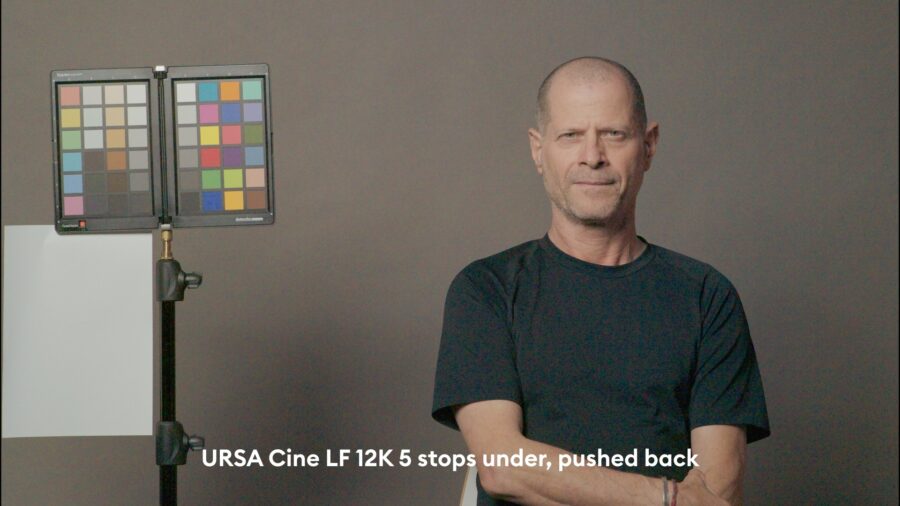
The noise easily cleans up in post using these settings in DVR 19:
Here is the 5 stops under, noise-reduced image:
As can be seen, the image is perfectly fine, and we are at 8 stops of exposure latitude! This looks way better than the image of the other full-frame Blackmagic camera, the Cinema Camera 6K, which we tested here and which reached its limits at 8 stops of exposure latitude.
Now, there are not a lot of full-frame cameras that can top the 8 stops. There is the RED Raptor [X] (lab test here) and V-Raptor, which reached 9 stops of latitude (with some room towards 10), and the Sony Burano (lab test here), which is close to 10 stops. But, in the end, they were all outperformed by the ARRI Alexa Mini LF, which showed a solid 10 stops of latitude.
So, let’s push the URSA Cine 12K LF further to 9 stops (i.e., 6 stops under and pushed back to base):
Noise is starting to corrupt the image, and some faint vertical lines are starting to appear. Also, the colors start to fade, and a heavy cast towards green appears in the shadows.
Using noise reduction, we get the following image:
This is definitely borderline, but I would still consider it usable. In the moving image the noise is not very distracting. Also, my criterion is always the shadow side of our talent if the skin colors can still be recovered.
Now, let’s move to 10 stops of exposure latitude:
Noise is now corrupting the image to the extent that it cannot be recovered using noise reduction:
This is now definitely game over! Fixed pattern noise can be seen, there is a heavy color cast, colors as well as image details are fading away even though I didn’t use Luma noise reduction (spatial NR).
Also, if you compare this to the ARRI Alexa Mini LF at 10 stops of latitude (here), you can see how much better in terms of the details, color, and overall appearance the Alexa Mini LF looks.
Nevertheless, these results put the URSA Cine 12K LF on par with the RED Raptor [X] or V-Raptor 8K. And, it is capable of higher frame rates compared to the RED cameras as well. Wow!
Summary
In essence, the new Blackmagic URSA Cine 12K LF sets a new benchmark in terms of features and price. It comes in second best behind the Sony Venice 2 in the rolling shutter department (of course, we have to mention that there are global shutter cameras like the RED Raptor [X] or Sony A9 III that completely eliminate rolling shutter once and for all).
It scores superb values in the dynamic range department. When downscaled from 12K to 4K in postproduction, it is actually slightly better on paper (IMATEST) than our current benchmark, the ARRI Alexa Mini LF!
The real-world latitude test, however, puts the dynamic range results a bit into perspective – here, the result of 9 stops of exposure latitude is definitely 1 stop worse than our benchmark for full-frame cameras, the ARRI Alexa Mini LF (having 10 stops with some room towards 11). Our current leader in the dynamic range and latitude department is the ARRI Alexa 35, which exhibited 12 stops of exposure latitude.
This is by far the best Blackmagic Design camera in their lineup so far!
Are you eager to shoot with the new URSA Cine 12K LF camera? Are you planning to add this baby to your kit? Let us know in the comments below!




